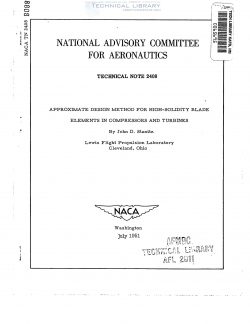naca-tn-2408
- Version
- 168 Downloads
- 2.97 MB File Size
- 1 File Count
- December 14, 2016 Create Date
- December 14, 2016 Last Updated
National Advisory Committee for Aeronautics, Technical Notes - Approximate Design Method for High Solidity Blade Elements in Compressors and Turbines

An approximate blade—element design method is developed for com-
pressible or incompressible nonviscous flow in high-solidity stators or
rotors of axial-, radial—, or mixedrflow compressors, turbines, or two-
dimensional cascades. The method is based upon channel-type flow
between blade elements on a specified surface of revolution that lies
between the hub and shroud (casing) and is concentric with the axis of
the compressor or turbine. The blade element is designed for prescribed
velocities along the blade-element profile as a function of distance
along meridional lines on the surface of revolution. The method is
limited, because of assumptions, to prescribed velocities that result in
blade-element profiles with gradual variations in thickness and with
minimum.radii of curvature at least approximately equal to the channel
width between profiles.
Two numerical examples are presented: The first example is the
design of a blade-element profile for a plane two-dimensional cascade in
compressible flow with prescribed velocities along the profile; the
second example is the design of a blade element for the impeller of a
mixed-flow centrifugal compressor. In both examples the design method
has been checked by comparing the prescribed velocity distribution with
the velocity distribution obtained by streamrfilament methods from the
resulting blade-element design.
Mbst aerodynamic losses in compressors and turbines result from
the viscosity and compressibility of the fluid. (Other losses, for
example, are associated with the trailing vortex sheet that sheds from
the trailing edge of the blade if the circulation around the blade
elements varies along the span of the blade.) Because the fluid is
viscous, losses result from boundary—layer friction and separation and
from secondary flows associated with the boundary layer. The magnitude
of these losses depends on the boundary-layer thickness, the size of
which is controlled by the velocity distribution just outside the
boundary layer. In.particular, if the velocity decelerates too rapidly,
the boundary layer thickens and separates, causing large mixing losses.
| File | Action |
|---|---|
| naca-tn-2408 Approximate Design Method for High Solidity Blade Elements in Compressors and Turbines.pdf | Download |

Comment On This Post